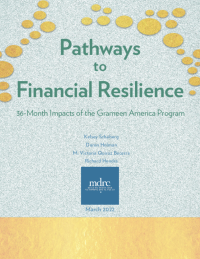Pathways to Financial Resilience
36-Month Impacts of the Grameen America Program

 This report summarizes 36-month findings from the evaluation of the Grameen America program, a microfinance institution that provides loans to women with low incomes in the United States who are seeking to start or expand a small business. Its objective is to reduce poverty through the provision of small loans, financial training, and peer support.
This report summarizes 36-month findings from the evaluation of the Grameen America program, a microfinance institution that provides loans to women with low incomes in the United States who are seeking to start or expand a small business. Its objective is to reduce poverty through the provision of small loans, financial training, and peer support.
The Grameen America evaluation used a randomized controlled trial design to explore the mechanisms of program operations and whether the model leads to improved outcomes for borrowers. The evaluation includes an implementation analysis, which examines how the program operates and the experiences of borrowers and program staff, and an impact analysis, which assesses the program’s effects on participants’ outcomes, including the study’s two primary outcomes: overall net income and types of material hardship. Other outcomes include wage-based work and self-employment, wage-based and self-employment earnings and other income, credit scores, savings, assets and remittances, social support, and financial well-being. The implementation analysis includes outcomes from program-tracking data, as well as findings from interviews with borrowers and Grameen America staff, focus groups, and researchers’ observations of the program. The impact findings in this report are based on study participants’ responses to a 36-month survey and credit report data from a major credit reporting agency. The Grameen America evaluation was funded by the Robin Hood Foundation.
Key Findings
- The evaluation provides evidence that the Grameen America program contributed to reducing the types of material hardship experienced. The program also produced a positive but modest increase in monthly net income (defined as a woman’s earnings from any business, wage-based job, and other sources, minus business expenses), though the evidence is not as definitive. The difference in net income seems related to higher average earnings from a business. The program did not have an effect on wage-based employment.
- Grameen America also increased nonretirement savings, increased the likelihood of having a VantageScore (a type of credit score), deepened relationships among members of loan groups, broadened social support systems, and increased overall well-being.
- The evaluation suggests that the relationship among wage-based work, business ownership, savings, and material hardship is complex. Overall, the evidence suggests that there were several ways material hardship might have been reduced. Increased cash flow from the loans might have allowed women in the program to meet financial obligations and thus reduce material hardship. Increased social support among Grameen America program participants may have reduced material hardship by giving women someone to turn to in a time of need. Increased savings may have given women additional funds to draw on. Increases in VantageScores may also have reduced material hardship by giving women access to other financial products such as credit cards to use to cover expenses. Future research could provide more insights into these complexities.
Overall, the study found it was not just increased income or just the loan that led to the program’s positive effects. The weight of the evidence suggests that women who experience life circumstances similar to those in the Grameen America program are likely to be more financially resilient in the face of unexpected challenges if they are offered more options to combine work and businesses, more ways to strengthen their peer networks, and more liquidity. Understanding the financial lives of the women served by Grameen America at a more granular level is an important area for future research.






